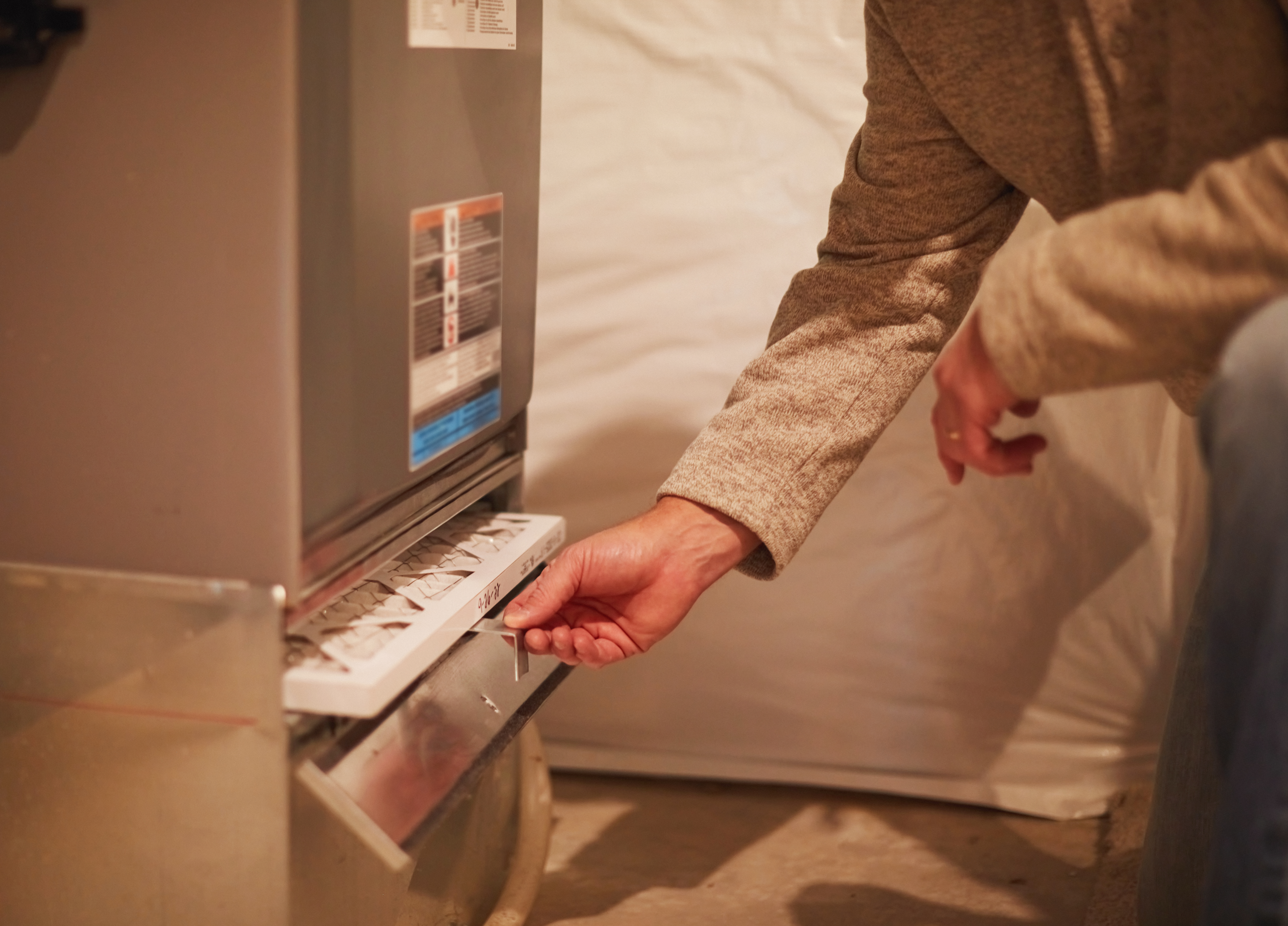Winter temperatures in Frederick, MD regularly dip below freezing. Maintaining a functioning heater is essential for preventing ruptured pipes and keeping everyone in your home safe and warm. With the even, steady heating that natural gas furnaces supply, they’re a top choice for residential heating throughout the region. However, heat pumps have also made a name for themselves with high levels of efficiency.
Read on to find out how you can use these two popular appliances together by installing a dual-fuel heating system.
What the Typical HVAC System Looks Like
Many standard central HVAC systems have furnaces for heating and air conditioners for cooling. Heater and AC air handling units are installed indoors. On the exteriors of buildings, AC condenser units are installed on composite or concrete pads in back or side yards and occasionally on roofs.
HVAC technicians connect heaters and air conditioners to central HVAC ducting, which distributes the conditioned air they produce. These shared air distribution systems require a balance of static pressure to keep air flowing. Sealing HVAC air vents shut, setting blower fan speeds to high, or failing to change air filters obstructs airflow, increases static pressure, and causes HVAC equipment to ice over, overheat, or shut down. For these and countless other reasons, it’s impossible to use two different types of heating equipment at once when both heaters share the same ducting.
Why Homeowners Replace Their ACs With Heat Pumps
Under the 2022 Inflation Reduction Act, homeowners are granted tax rebates for replacing their central air conditioners with heat pumps. According to the U.S. Environmental Protection Agency (EPA), these rebates can cover up to 30% of a heat pump’s installation costs or up to $2,000.
In summer, heat pumps and air conditioners are functionally identical. Both have indoor air handling units and outdoor condensers, and both cool building interiors down by extracting the heat from warm indoor air with icy refrigerant and recirculating the cooled air throughout the building.
However, heat pumps also have internal reversing valves that switch the flow of refrigerant and reverse the cooling process. Rather than extracting warm indoor air and absorbing its heat, heat pumps that are in heating mode transfer heat from the outdoor air into living spaces. This heat transfer process is currently one of the most efficient heating methods available. In the right conditions, this allows some heat pumps to function at efficiency levels as high as 300%. At that efficiency, heat pumps are producing three times as much heat energy as they’re consuming in electricity.
The Drawbacks of Using Heat Pumps as Primary Heaters in Cold Climates
As heaters, heat pumps perform best when the outdoor weather is only moderately cold. For instance, in late fall and early winter, when temperatures in Frederick are above freezing, a central heat pump could heat your entire home while maintaining efficiency levels that are well over 100%. However, when the outside temperature dips below 32 degrees Fahrenheit, heat pump efficiency and performance decline.
Moreover, efficiency and performance losses are progressive with each degree that the outdoor temperature goes down. In below-freezing weather, many heat pumps struggle to source enough outdoor heat to bring inside. Should a surprising cold snap ever roll in, some heat pumps could ice over and stop working altogether.
Many heat pumps have built-in technology to help mitigate this, luckily, but it’s something to be aware of with Frederick winters.
The Drawbacks of Heating Your Home With Natural Gas
Natural gas furnaces burn hotter than any other residential heating equipment type. This allows them to heat homes rapidly and with minimal fuel use. Unfortunately, all fuel-combusting appliances produce harmful exhaust gases like carbon monoxide during operation. Although these gases are routed outdoors before they can negatively impact human health, there’s always the potential for exhaust leaks. There’s also the ongoing negative effects that these emissions have on the environment.
Dual-Fuel Systems: What It Means to Use Heat Pumps and Furnaces Together
There’s certainly no problem with using heat pumps and furnaces to create complete HVAC systems. Heat pumps are excellent stand-ins for air conditioners. However, with the right setup, you can also leverage your heat pump for heating during times of ideal operating conditions. When outside temperatures fall too low for efficient heat pump operation, your HVAC system can automatically toggle to your furnace for heating.
Two Heaters, One Output
Using a heat pump and a furnace together doesn’t mean you use both heaters at the same time — that is, having a heat pump and a furnace doesn’t mean having more heat. Instead, it means having more heating options. In the right conditions, both systems should have the ability to heat your entire home by themselves. If either cannot, there’s a good chance that they’re too small to handle the heating load your home requires.
Hybrid Electrification and Its Many Benefits
Dual-fuel HVAC systems with heat pumps for air conditioning and heating and furnaces as alternative heat sources are cited by the EPA as being an excellent step toward electrification. Also known as hybrid electrification, these combinations move residential properties closer to increasingly stringent zero-emissions goals.
One of the drawbacks of using heat pumps as standalone heating solutions is the fact that electricity rates can be higher than gas prices. Even though heat pumps can produce more heat energy than they consume in electric energy, if electricity prices are high, they become increasingly costly to run as outside temperatures decline. Hybrid electrification with dual-fuel systems allows homeowners to take maximum advantage of prime operating conditions while seamlessly transitioning to their gas furnaces when natural gas consumption is the cheaper and more feasible choice.
Seamless Integration of Dual-Fuel Systems
HVAC systems comprised of heat pumps and furnaces aren’t automatically dual-fuel heating systems. If you intend to use your heat pump for both heating and cooling, you should let your HVAC installer know. Dual-fuel systems require dual-fuel heat pumps that are specially designed to transfer heating needs to attached furnaces. Pairing these appliances with smart thermostats and automating the transition from heat pump heating to furnace heating will help you get the most from this arrangement.
Cut Your Chances of Experiencing a Heating Emergency
Investing in a dual-fuel heat pump is a great way to limit your risk of heating emergencies. When outside temperatures dip below freezing, if your furnace or heat pump ever fails, you can count on your second heater to keep the building interior warm, decreasing the risk of frozen pipes and other issues.
Adjusting Your Heat Pump Maintenance Schedule to Account for Winter Use
One important thing to note about installing and using a dual-fuel heating system is that it requires additional maintenance. Before winter arrives, you should schedule annual furnace maintenance to prime the system for the demands that lie ahead. Dual-fuel heat pumps require service in late spring or early summer to prepare them for the cooling season. They ideally should get maintenance again before performing their winter heating duties.
At Markool Heating & Cooling, we help homeowners in Frederick, MD make informed decisions when purchasing new heating and cooling equipment. We provide expert heating installation, cooling, plumbing, and duct cleaning services. We also offer drain cleaning services, heat pumps, and HVAC preventative maintenance plans. To find out more about dual-fuel heating systems and hybrid electrification, contact Markool Heating & Cooling!






